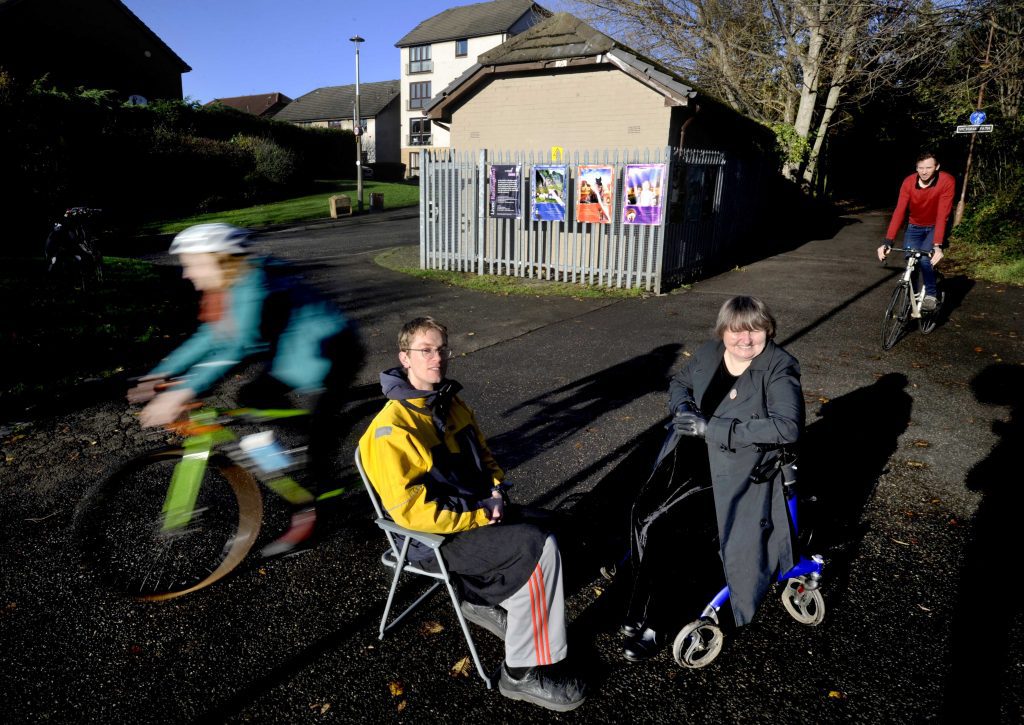Disability History in Scotland celebrated by artworks and events along walking, wheeling and cycling routes
- Between the 16thNovember and the 16th December (2022), a series of art installations and performances celebrating Disability History Month will take place along traffic-free National Cycle Network routes in Scotland.
- Art installations, performances and events will take place in Edinburgh, Paisley and Dumfries.
- Disability History Month is an annual, month-long celebration of Disability history, focusing on the history of Disabled people’s struggle for equality and human rights.
- The four pieces created along the National Cycle Network celebrate notable Disabled people, movements and locations from Scotland’s history that have made it the country it is today.
A programme of art and events on Scotland’s walking, wheeling and cycling routes has been launched as part of 2022’s Disability History Month celebrations across the country.
Announced by walking, wheeling and cycling charity Sustrans, the artworks and events can be found along National Cycle Network routes between 16th November and 16th December 2022.
The pieces by artists Sasha Saben Callaghan, Ellen Renton, Hector Dyer and Dylan Esposito will be unveiled in Edinburgh, Paisley and Dumfries.
Disability History Month is a UK-wide celebration of Disability history held annually since 2010. It focuses on the history of Disabled people’s struggle for equality and human rights.
The theme of this year’s celebration is Disability, Health and Well Being.
Supported by an external steering group of artists, historians and consultants, Sustrans commissioned the 4 artists to deliver unique artworks or performances reflecting this theme along traffic-free National Cycle Network routes in Scotland.
It is hoped they will encourage everyone to reflect on change and highlight what still needs to be done to achieve equality for Disabled people.
Disability History Month Scotland (DHMS) was formed in 2011 by a small group of Disabled people, with endorsement and support from UK Disability History Month’s steering group.
Artist Sasha Saben Callaghan is one of the founders of DHMS. She is a writer, disability equality trainer and creator of ‘Leith Lives: Re-imagined’, which is on display beside National Cycle Network Route 75 and the Water of Leith in Edinburgh.
‘Leith Lives: Re-imagined’ focuses on the histories of six disabled ‘inmates’ from the North and South Leith Poorhouses, transforming their stories into the mythical, the beautiful and the uncanny through collage.
Sasha said: “Disability History Month is now firmly established in the Scottish calendar.
“I am delighted to have been asked to create a public art installation to celebrate the lives of Disabled people who have helped shape the Scotland we know today.”
The artists individually selected a section of the National Cycle Network relevant to the story they want to tell through their work.
The successful commissions include print and sculptural works alongside poetry and textile arts.
Deborah Murray, artist and member of the Disability History Month steering group, said:
“It was a joy and a privilege to be asked by Sustrans to participate in this event for Disability History Month.”
“As a member of the steering group who is also a disabled person, it was important to contribute to the conversations that emerged around art and active travel.
“Disability can place people at a much higher risk of isolation. I believe that in difficult times it is more important than ever to encourage and maintain a sense of connection within our community.
“What better way to do that than placing thought-provoking art along the National Cycle Network.”
Disabled people are currently underrepresented within trips along the National Cycle Network and across all active travel journeys.
Sustrans’ recent nationwide Walking and Cycling Index study found that only 12% of disabled people cycle weekly, compared to 19% of non-disabled people.
Similarly, 45% of disabled people reported that they walk or wheel at least five days a week, compared to 52% of non-disabled people.
This is not because there isn’t demand from people in these groups to make active and sustainable journey choices. It’s because barriers to participation are often amplified.
Karen McGregor, Director, Sustrans Scotland said:
“We’re so pleased to be working alongside such talented artists to mark Disability History Month along the National Cycle Network in Scotland”.
“Sustrans are working hard to become a charity for everyone, but we know there is a lot of work to be done to realise this vision.
“By highlighting lived experiences and the contributions of Disabled people across active travel, we want this project to be a catalyst for ongoing conversation and positive change.
“Sustrans hope this project inspires people across the country to walk, wheel and cycle to these incredible artworks and engage with our work to make active travel a safe, accessible and attractive choice for everyone in Scotland.”
Hector Dyer’s work ‘It Is A Long Lane That Has No Turning’ is a series of woven panels along National Cycle Network Route 75, telling the story of Scottish weavers and the disabilities they developed through their trade.
Hector will also be running handloom weaving workshops with a disabled group in Paisley during Disability History Month.
“It has been really special to have the time to research these stories and have such freedom in how we tell them”.
“This commission has given me the opportunity to uncover generations of handweavers in Paisley and the legacy this trade has had upon their bodies and livelihoods.
“I have also found real inspiration from how they came together and supported one another through ongoing hardship.”
Edinburgh-based poet, performer and theatre maker Ellen Renton has created a poetry trail along National Cycle Network Route 1 in Edinburgh.
‘The Blind Factories’ will be on display from 16 November between the Innocent Railway Tunnel and Braid Burn.
Ellen said: “I’m really grateful to have had the opportunity to work on this project”.
“As a disabled artist I’m often expected to make work that comes from my own experience, but to be able to do research that places me in a wider community and helps me feel a part of something much bigger has been hugely significant.”
“Disability history is so often neglected, and so being able to not only shed some light on it, but to do so in a free, public space, is a real joy”.
Dylan Esposito’s ‘Hugh Blair of Borgue’ project focuses on the Scottish laird Hugh Blair, who is said to be the first documented autistic person in Scotland. It aims to reframe Blair in a positive light as an autistic person of Scottish historical significance.
The permanent sculpture will be installed along National Cycle Network 7 near the new hospital in Dumfries. Dumfries and Galloway.
“This has been a really exciting project to work on and I can’t wait to see all of the different work made by the other artists throughout Disability History Month”.
“It’s fantastic that Sustrans set up this project to highlight the often-forgotten history of Disabled people in Scotland, both past and present. Especially given that these pieces will exist in accessible, public spaces as opposed to the traditional, and often inaccessible gallery setting”.
For more information about the programme of artworks, including event dates and locations, please visit: https://www.sustrans.org.uk/our-blog/news/2022/november/disability-history-month-events-to-take-place-along-the-national-cycle-network-in-scotland/






